Explore As You Visit The Salvador Dali Museum And Garden In Spain
Cultural Traveling: Taking a Tour of the Salvador Dali House.
By Eben Diskin | Published on April 12, 2022
At first glance, Portlligat, Spain, might appear to be little more than a small village on the coast of the Mediterranean fit for fishermen. Defined by its seaside views and quaint charm, it sits an hour from the French border and just outside the town of Cadaques, whose population numbers under 3,000.

You may think that's Portlligat's whole story, until you see the Dali Museum — a grand white house that seems to drip down the stone steps like still-wet paint. The eccentric-looking house belonged to Salvador Dali, one of the world's most famous surrealist painters, and it now serves as a bewildering museum of his life and art. Spend any time in Portlligat while traveling to Spain and you'll quickly learn — from locals beaming with pride — that this village is where Dali first discovered the craft of modern painting and where he called home for much of his life.
You don't have to be a fisherman to appreciate Portlligat, and you don't have to be an art aficionado to enjoy the Dali museum.
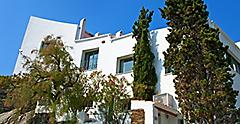
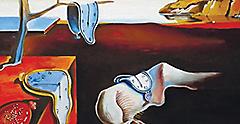
Who Was Salvador Dali?
Before he was a world-renowned artist, Salvador Dali was a peculiar child more interested in art and unusual fashion than his schoolwork. Born in Figueres, Spain, in 1904, Dali began producing sophisticated drawings at a young age, and his parents even built him an art studio. He grew up making frequent visits to the family's summer home in the village of Cadaques — about an hour south of Figueres — and it was there he discovered modern painting and met Ramon Pichot, a local artist and the influence behind Dali's iconic style.
Dali began attending the Academia de San Fernando in Madrid in 1922, where he was known for his offbeat style, with his long hair, sideburns, and 19th-century clothes. Though ultimately expelled for offending his professors, he was exposed to a range of artistic styles, from metaphysics to cubism and avant-garde movements, and classical painters like Raphael, Velazquez, and Bronzino.
In 1929, Dali purchased a small seaside home in Portlligat, near Cadaques, and began producing oil paintings. This is where he developed his "paranoiac-critical method" — a mental exercise wherein Dali accessed the subconscious to boost his creativity. The resulting paintings were small collages of images from his dreams and subconscious thoughts.
Dali was actually expelled from the Surrealist movement in 1934 when he refused to speak against Spanish general Francisco Franco. However, he continued to participate in international Surrealist exhibitions, and he and his wife Gala moved to the United States during World War II. They stayed there until 1948, and then returned to their coastal home in Portlligat. Dali purchased all of the homes surrounding his to form a grand white compound. He would live there for the next 30 years, primarily producing work with historical, religious, or scientific themes. Incorporating optical illusions, holography, and geometry, these pieces are part of his "Nuclear Mysticism" period, and they're considered some of his finest works.
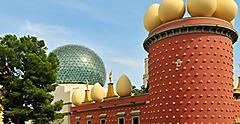

Viewing Inside The Salvador Dali House
Salvador Dali moved around for much of his life, but the Portlligat house was the closest thing to a stable residence he ever had, living there intermittently from 1930 to 1982. The peaceful landscape, isolation and brilliant sunlight that flows into the home are what attracted him to the place. When you see it for yourself, you'll immediately be struck by the abundance of these three attributes: beauty, solitude and light. Dali even went so far as to install an angled mirror in his bedroom, so he could awaken each morning and watch the sunrise from the comfort of his bed.
On your way to the house, you'll be able to spot it from afar due to the massive sculpture of a white egg that sits atop the roof. Eggs are a recurring theme across Dali's work, and he saw them as a symbol of positivity, love and rebirth. So, as you explore his home, keep an eye out for all of the egg imagery.
The house began as a shack with a roof in ill repair, and over the years, Dali purchased more and more surrounding huts to add to his compound. The result is a whimsical labyrinthine complex with the "Bear Lobby" as the epicenter, where you're greeted by a taxidermy polar bear that towers over you as soon as you walk in. This seems bizarre enough, but then you experience the various chambers throughout the home, linked by winding, confusing passageways and know that it's only the tip of the iceberg.

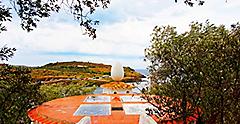
Indeed, a tour of the Dali Museum isn't like strolling through the orderly halls of The Metropolitan Museum of Art. Instead of carefully curated exhibits and neatly arranged paintings lining the walls, here you'll venture through twists and turns that often lead to dead ends and a diverse collection of Salvador Dali's artifacts and unfinished art. His obsession with stuffed swans is on full display in the library, for example, while the walls of the Cupboard Room are decorated with original photos and magazine clippings collected by his wife.
Among the most unique rooms are the Oval Room, an almost hemispherical shape based on a design Dali had done for a party hall in Acapulco. It's an eye-catching circular space with glass skylights used by Dali as a second workshop for sculptures and performances.
Much of his unfinished artwork can be found in the studio — my personal favorite room in the house. Dali viewed the studio as a sacred space, and as such, natural light paints the room from the large east window, where you'll also have sweeping views of the harbor. There's something strangely overwhelming about standing in the space where the artist worked and seeing the very instruments he used to create his masterpieces. The studio, more than any other space, makes you feel like Salvador Dali is still alive and continuing to produce art from the cozy sanctuary of Portlligat.
You will also be amazed by the sheer volume of original photographs depicting Dali and Gala throughout the home. These photographs are an intimate window into the artist's domestic life and tell their own unique story, so make sure to keep an eye out for them during your tour.
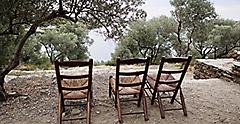
Outside The Home, Touring The Salvador Dali Garden
It's also worth noting that to visit the museum, you'll need to book in advance as it sells out quickly. However, if you don't snag a ticket to see the interior of the home, there's plenty to see on the grounds of the compound.
You can wander the gardens at your leisure, observing the odd layout and beauty. It's a trip inside the subconscious mind of Salvador Dali. Narrow steps lead down to the centerpiece of the yard: an extravagant pool adorned with fountains, a playground, stuffed animals and Dali's iconic Mae West-inspired lip sofa. The gardens, which are actually more of an olive tree courtyard, frame the stunning views of Cadaques.
You could spend an entire day at the Salvador Dali House in Portlligat and still not see everything. With all of the details hidden throughout the home, you could return to Spain time and time again. This over-the-top display of his art proves that Dali was a complicated yet brilliant man, and you're sure to leave the museum inspired.





